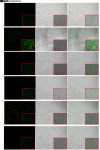Protective effect of recombinant Lactobacillus plantarum against H2O2-induced oxidative stress in HUVEC cells
- PMID: 33973418
- PMCID: PMC8110467
- DOI: 10.1631/jzus.B2000441
Protective effect of recombinant Lactobacillus plantarum against H2O2-induced oxidative stress in HUVEC cells
Abstract
This study probed the protective effect of recombinant Lactobacillus plantarum against hydrogen peroxide (H2O2)-induced oxidative stress in human umbilical vein endothelial cells (HUVECs). We constructed a new functional L. plantarum (NC8-pSIP409-alr-angiotensin-converting enzyme inhibitory peptide (ACEIP)) with a double-gene-labeled non-resistant screen as an expression vector. A 3-(4,5-dimethyl-2-thiazolyl)-2,5-diphenyl-2H-tetrazolium bromide (MTT) colorimetric assay was carried out to determine the cell viability of HUVEC cells following pretreatment with NC8-pSIP409-alr-ACEIP. Flow cytometry (FCM) was used to determine the apoptosis rate of HUVEC cells. Cysteinyl aspartate specific proteinase (caspase)-3/8/9 activity was also assayed and western blotting was used to determine protein expression of B-cell lymphoma 2 (Bcl-2), Bcl-2-associated X protein (Bax), inducible nitric oxide synthase (iNOS), nicotinamide adenine dinucleotide phosphate oxidase 2 (gp91phox), angiotensin II (AngII), and angiotensin-converting enzyme 2 (ACE2), as well as corresponding indicators of oxidative stress, such as reactive oxygen species (ROS), mitochondrial membrane potential (MMP), malondialdehyde (MDA), and superoxide dismutase (SOD). NC8-pSIP409-alr-ACEIP attenuated H2O2-induced cell death, as determined by the MTT assay. NC8-pSIP409-alr-ACEIP reduced apoptosis of HUVEC cells by FCM. In addition, compared to the positive control, the oxidative stress index of the H2O2-induced HUVEC (Hy-HUVEC), which was pretreated by NC8-pSIP409-alr-ACEIP, iNOS, gp91phox, MDA, and ROS, was decreased obviously; SOD expression level was increased; caspase-3 or -9 was decreased, but caspase-8 did not change; Bcl-2/Bax ratio was increased; permeability changes of mitochondria were inhibited; and loss of transmembrane potential was prevented. Expression of the hypertension-related protein (AngII protein) in HUVEC cells protected by NC8-pSIP409-alr-ACEIP decreased and expression of ACE2 protein increased. These plantarum results suggested that NC8-pSIP409-alr-ACEIP protects against H2O2-induced injury in HUVEC cells. The mechanism for this effect is related to enhancement of antioxidant capacity and apoptosis.
Keywords: Apoptosis; Human umbilical vein endothelial cell (HUVEC); Hydrogen peroxide (H 2 O 2); Oxidative stress.
Figures










Similar articles
-
Protective effect of Ziziphora clinopodioides flavonoids against H2O2-induced oxidative stress in HUVEC cells.Biomed Pharmacother. 2019 Sep;117:109156. doi: 10.1016/j.biopha.2019.109156. Epub 2019 Jul 1. Biomed Pharmacother. 2019. PMID: 31387192
-
Dihydromyricetin protects endothelial cells from hydrogen peroxide-induced oxidative stress damage by regulating mitochondrial pathways.Life Sci. 2015 Jun 1;130:38-46. doi: 10.1016/j.lfs.2015.03.007. Epub 2015 Mar 26. Life Sci. 2015. PMID: 25818185
-
2,3,5,4'-tetrahydroxystilbene-2-O-β-D-glucoside protects human umbilical vein endothelial cells against lysophosphatidylcholine-induced apoptosis by upregulating superoxide dismutase and glutathione peroxidase.IUBMB Life. 2014 Oct;66(10):711-22. doi: 10.1002/iub.1321. Epub 2014 Nov 7. IUBMB Life. 2014. PMID: 25382724
-
Protective effects of luteolin against oxidative stress and mitochondrial dysfunction in endothelial cells.Nutr Metab Cardiovasc Dis. 2020 Jun 9;30(6):1032-1043. doi: 10.1016/j.numecd.2020.02.014. Epub 2020 Mar 9. Nutr Metab Cardiovasc Dis. 2020. PMID: 32402583
-
Anti-oxidant potential of plants and probiotic spp. in alleviating oxidative stress induced by H2O2.Biomed Pharmacother. 2023 Sep;165:115022. doi: 10.1016/j.biopha.2023.115022. Epub 2023 Jun 17. Biomed Pharmacother. 2023. PMID: 37336149 Review.
Cited by
-
Inhibition of Myocardial Cell Apoptosis Is Important Mechanism for Ginsenoside in the Limitation of Myocardial Ischemia/Reperfusion Injury.Front Pharmacol. 2022 Mar 1;13:806216. doi: 10.3389/fphar.2022.806216. eCollection 2022. Front Pharmacol. 2022. PMID: 35300297 Free PMC article. Review.
-
Alr Gene in Brucella suis S2: Its Role in Lipopolysaccharide Biosynthesis and Bacterial Virulence in RAW264.7.Int J Mol Sci. 2023 Jun 28;24(13):10744. doi: 10.3390/ijms241310744. Int J Mol Sci. 2023. PMID: 37445922 Free PMC article.
-
Evaluation of the immunogenicity of auxotrophic Lactobacillus with CRISPR-Cas9D10A system-mediated chromosomal editing to express porcine rotavirus capsid protein VP4.Virulence. 2022 Dec;13(1):1315-1330. doi: 10.1080/21505594.2022.2107646. Virulence. 2022. PMID: 35920261 Free PMC article.
-
Lactobacillus delbrueckii Alleviate Oxidative Stress and Intestinal Injuries by Activating TLR2 and TLR4 Expressions in IPEC-J2 Cells.Probiotics Antimicrob Proteins. 2025 Feb 11. doi: 10.1007/s12602-025-10466-w. Online ahead of print. Probiotics Antimicrob Proteins. 2025. PMID: 39932646
-
Novel Antioxidant Peptides Identified from Arthrospira platensis Hydrolysates Prepared by a Marine Bacterium Pseudoalteromonas sp. JS4-1 Extracellular Protease.Mar Drugs. 2023 Feb 20;21(2):133. doi: 10.3390/md21020133. Mar Drugs. 2023. PMID: 36827174 Free PMC article.
References
MeSH terms
Substances
LinkOut - more resources
Full Text Sources
Other Literature Sources
Medical
Research Materials
Miscellaneous

